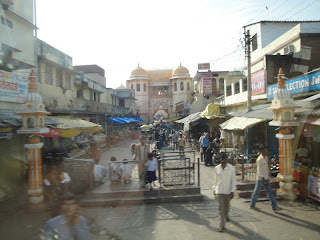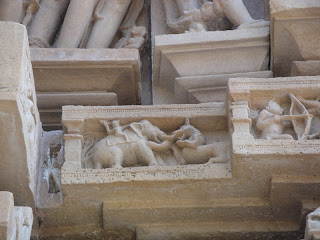 Another early wake-up call (actually there were always two). The train to Jhansi was supposed to depart from the train station at 8:17 am. Well, it didn't happen! We were there ... in good time. The train was not. Not for three hours.
Another early wake-up call (actually there were always two). The train to Jhansi was supposed to depart from the train station at 8:17 am. Well, it didn't happen! We were there ... in good time. The train was not. Not for three hours. 
There was a lot to see though and we were well entertained by the station activity.
I regret that I do not take enough pictures. What was I thinking? I guess I was too busy observing. Most entertaining were the trains standing for a while on the other track. The woman who was brushing her teeth out of the open door. The men (several) who climbed out of a window to go pee (in the direction of their train, luckily).
This we saw when there was no train on the other truck. The fire prevention!!! Some of those hanging buckets are filled with sand, some with water!
Because of the crowd we were warned about pick-pockets. Nothing bad happened. Everybody o.k. But I think Praveen was nervous about it.
When the train finally came, it was all good. The ride was quite nice. There was even service of drinks and food. Ah, no thank you.
Some routine again when we disembarked in Jhansi: identify your suitcase to make sure everybody's is there.
Almost at every bus stop somebody would be begging, knocking on the window and gesturing. This boy was quite annoying but he really should have been in school. I hope this doesn't sound heartless, but we were told about it ...
Many times while riding in the bus I was sorry that I could not take a picture of a statue ... or ... or ... or.
Delhi had some fascinating statues. Here again ... James snapped this one for me on "his" side.
Mahatma Gandhi leading the Salt March (11 figures).
The "graffiti" on the houses ... ?
Political campaign for the next election.
Leaving the Orchha Resort after lunch.
Orchha is dramatically positioned on a rocky island, enclosed by a loop of the River Betwa. Founded in 1531, it was the capital of the Bundela kings until 1738, when it was abandoned in favour of Tikamgarh.
Crumbling palaces, pavilions, hamams (public baths), walls and gates connected to the town with an impressive 14-arched causeway, are all that remain today.
Because of the train delay, we had to drive the rest of our bus journey in the dark. This picture is my only reminder, but then ... I don't really need a reminder. This experience might stay with me for a while. The paved road is usually just wide enough for one truck. Left and right is usually a shoulder but it can drop a foot or so. If the road has potholes, the shoulders are much worse. So if something (with or without lights) comes towards you, one of you has to give. Or both go down with the outer wheels. How they know who does what? And kind of at the last minute. To be fair I must say that I was never really afraid. Not in the light and not in the dark because we could see that our drivers were terrific. The feeling was more that of an amusement park ride. But we were all happy when we arrived at the Taj Chandela.Oh yes, our itinerary called them "rough rural roads".
 Hotel art.
Hotel art.
A bit chilly but a nice place to just sit.
First view. Khajuraho is known the world over for its temples, architecture, and erotic sculptures. There are 22 Hindu temples left out of 85 originally built here dating to the 10th century. It is protected as a UNESCO World Heritage site.
Built during the 500-year reign of the Chandela dynasty, the temples here represent a burst of creative and religious energy that faded as Islam gained influence and Hindu Khajuraho ultimately was abandoned. When Muslim invaders destroyed many relics of Hinduism throughout India, Khajuraho was out of harm's way because of its remote location which, ironically resulted in the well preserved temples we can explore today.
The temples are adorned with wonderful sculptures and represent the finest examples of temple architecture in northern India.
Some of the sculptures are very erotic, commonly called Kamasutra. There are many interpretations of the erotic carvings. Some think that they are meant to be a reminder that life should be enjoyed to the fullest. Others think the carvings portray that, for seeing the deity, one must leave his or her sexual desires outside the temple.Of course as always there are monkeys around. This one really looks like one of the carved features.
A lot of renovation/restoration is going on. You can recognize the new pieces by the color. Lately new pieces are not carved any more. To distinguish them from the really old, they are left plain.
Inside the Lakshman Temple (always take your shoes off).
The ceiling.
Lakshman temple.
These were remnants laying around behind the temple because they probably don't know where they belong. Probably from the other 63 temples which have not survived so well.
The temples were totally overgrown by the jungle. A British officer found them in the late 19th century while hunting.

A mongoose running across the lawn.
Every time we leave the bus to visit a special sight, Praveen reminds us that our "friends" will greet us on our return with their wares. The hawkers usually walk next, in front, or behind us while waving things into our faces. When we are coming back from the sight, things get cheaper. When we are in the bus (see picture) they offer the real price (or so we think, haha). A lot of purchasing is going on then ... with Praveen's help.
In this town we had to have also a local guide. He told the hawkers that he would deal with the one at the very end of the queue (which helped just a little while).
These are the Jain temples. Jainism is similar to Hinduism.

And again our "friends" at the bus door.
In the evening we went to a theater were we saw "Dances of India" performed.
Praveen arranged for us to have a lovely dinner on the hotel grounds outdoors. It was lovely.



























































1 comment:
I think I'm using up my adjectives too soon. Astonishing temples. Jainism is really interesting. They are seriously radical vegans. Many won't eat root vegetables and flour because tiny organisms get killed during harvesting.
Post a Comment